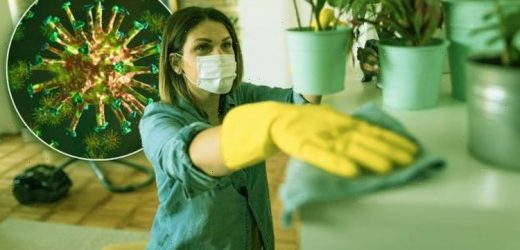Covid variant: Expert on concerns over 'double-mutant' strain
When you subscribe we will use the information you provide to send you these newsletters. Sometimes they’ll include recommendations for other related newsletters or services we offer. Our Privacy Notice explains more about how we use your data, and your rights. You can unsubscribe at any time.
Covid has killed almost 130,000 people in the UK since the start of the pandemic more than a year ago. Scientists have now revealed that Covid remains in household dust for up to a month, which marks a huge milestone in identifying potential outbreak sites.
More than four million people have tested positive for coronavirus in the UK over the past 13 months.
At the height of the pandemic between December and January 2020, almost 60,000 people were testing positive every day.
While the number of new daily cases is significantly lower now, scientists have made another breakthrough in the fight against COVID-19.
They’ve discovered that Covid remains in dust for a long time.
Dust is the general name given to various particles in the atmosphere that clump together.
It’s usually made out of deadly skin cells, bacteria, clothing fibres, hair and tiny parts of plastic.
But it could also harbour viruses and pollution, which increase the risk of infections.
Coronavirus genetic material can remain inside dust for almost an entire month, according to scientists at Ohio State University.
DON’T MISS
Covid symptoms update: Seven uncommon signs of COVID-19 [ANALYSIS]
Covid vaccine and blood clots: What are the symptoms of CVST? [EXPLAINER]
Covid vaccine: What is capillary leak syndrome? [RESEARCH]
Experts could use these findings to predict future outbreaks of Covid in residential settings – for example, care homes or hospitals.
The virus’s protective barrier is likely to be broken, however, which means it may not be able to spread to other humans.
“When the pandemic started, we really wanted to find a way that we could help contribute knowledge that might help mitigate this crisis,” said the author of the study, Karen Dannemiller.
“We’ve spent so much time studying dust and flooring that we knew how to test it.”
Local authorities have previously tested wastewater to estimate the prevalence of Covid in various communities.
Testing dust from homes, hospitals, or even vacuum bags could play a similar role in understanding how widespread the virus might be, the experts said.
Lead author of the study, Nicole Renninger, said: “In nursing homes, for example, you’re still going to need to know how Covid is spreading inside the building.
“For surveillance purposes, you need to know if you are picking up an outbreak that’s going on right now.”
The scientists analysed dust samples from Covid patients’ homes, who were self-isolating. They collected the dust from vacuum bags, as well as general surface swabs.
The Covid genetic material was found in 97 percent of dust samples, as well as 55 percent of surface swabs.
“We weren’t sure that the genetic material would survive – there are many different organisms in dust, and we weren’t sure we’d see any viral RNA at all,” said Renninger.
“We were surprised when we found that the actual RNA itself seems to be lasting a pretty long time.”
Source: Read Full Article




